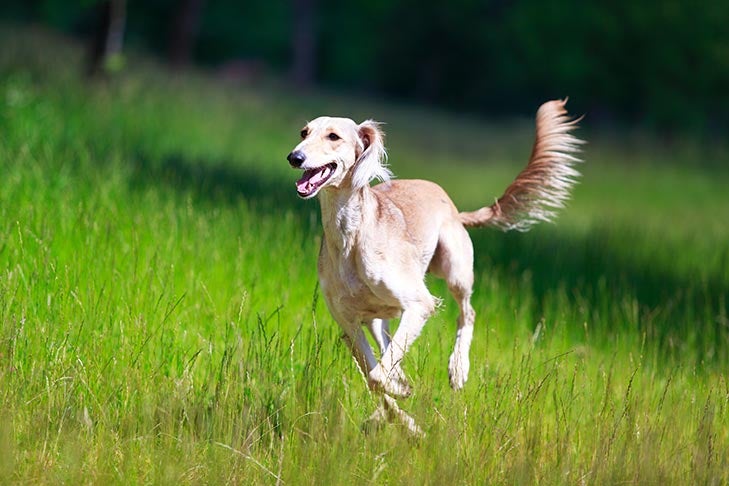
The sleek and graceful Saluki has hunted with humankind for thousands of years. Because the history of this ancient sighthound reaches back long before the invention of breed clubs and written records, the breed’s origin is veiled in mystery. Here are 10 interesting facts about this beautiful breed.
1. The Saluki Is One of the Oldest Known Breeds
There is robust archaeological evidence of the Saluki that dates back at least 5,000 years. Images of slender dogs with feathered ears, tails, and legs have been found on tomb paintings and mosaics in the Middle East.
2. They’re Sometimes Called “the Royal Dog of Egypt”
Egyptian nobility considered the breed to be a valuable and honored companion, and they were known to mummify the dogs in the fashion of the Egyptian pharaohs. The remains of dogs have been found in tombs on the Upper Nile.

3. Arab Tribesmen Highly Valued Salukis
These dogs were thought to be a gift from God. They were called “el hor,” which means “the noble” in Arabic.
The tribesmen paid as much attention to the breeding of their Salukis as they did to their Arabian horses, prizing speed, endurance, and a keen hunting instinct. Salukis are still used for hunting today in the Middle East.
4. Salukis Are Sighthounds
A member of the Hound Group, the Saluki is also a sighthound. Sighthounds rely on their eyesight, rather than their noses, to find prey and then use their tremendous speed for the chase and capture. Because Salukis are too fast for humans to keep up with, they work alone. This has given them an independent personality.
5. They Have Tremendous Stamina and Strength
These dogs were bred to chase prey over long and difficult ground, so they are not as fragile as they look. Salukis can run 30-35 miles per hour, and some breeders say Salukis can run almost 50 miles per hour, which explains why Arab tribesmen used them for hunting gazelle. Henna or nut oil was applied to the dogs’ feet to harden them and prevent injuries.
6. Salukis Need to Run at Least Once or Twice a Week
Simple walks around the block are not enough to satisfy their needs. So a Saluki owner benefits from a very large, fenced yard or regular access to a similar area for exercising their dog. However, the fence needs to be at least five feet high, and preferably six, because Salukis are phenomenal jumpers and can easily clear anything shorter.

Salukis will chase most small animals, sometimes catching and killing them. You can teach a Saluki obedience in a controlled situation, but in an open field, especially if there’s a squirrel in sight, they may not return to you consistently when you call.
7. Their Coat Is Short, Soft, and Silky
A Saluki’s coat can be either feathered or smooth. The feathered variety has feathering, or longer hair, on the ears, tail, and on the thighs and backs of the legs, whereas the smooth does not. Both have “hare feet” – pads between their toes that allow them to run in deep sand.
The coat sheds very little and only requires weekly brushing, twice weekly for the feathering. Salukis come in many colors and patterns, including white, cream, fawn, golden, red, grizzle and tan, tricolor, and black and tan.
8. The Breed Standard Calls For a Dignified and Gentle Expression
The AKC breed standard also says that the expression in a Saluki’s dark-to-hazel-colored eyes should be deep, faithful, and farseeing. They are curious dogs, and their loyalty helps them become lovingly attached to their owners. Although they are devoted to their owners, they are also independent souls who can be aloof and cat-like.

It’s important to stay patient and positive with your Saluki to maintain their interest and ensure training success. Proper socialization will help this sensitive hound develop confidence.
9. Salukis Enjoy the Good Life…and Dog Sports!
Due to their lack of natural padding, they appreciate soft surfaces to lie on, such as the couch, an easy chair, or your bed. But don’t forget that they are high-functioning athletes that benefit from a variety of mentally and physically challenging activities. They excel at lure coursing, agility, exhibition jumping, and flyball, for example. Salukis can live 10 to 17 years if kept healthy and in good shape.
10. They Were Given Names Reflecting Important Traits
As valued family members, Salukis were historically given appropriate names by their owners. Sometimes it took months to find just the right name for each dog. For example, known Saluki names include the Arabic words Nimran (panther), Saqar (falcon), Khataf (snatcher), Lateef (friendly), Sougha (the gift), Sharrek (partner), Shihaab (shooting star), Shadeed (strong), and Reasha (feathered).

